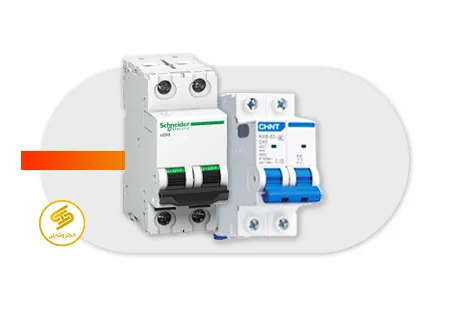What is a Miniature Circuit Breaker (MCB)?
A Miniature Circuit Breaker (MCB), also known as a Miniature Circuit Breaker fuse, is a type of protective and electrical switch used in electrical systems to prevent accidents caused by increased current or other electrical hazards. These switches are commonly used in distribution panels in homes, industries, and other places.
MCBs are of the automatic type, meaning that in the presence of excess current in the circuit, they automatically turn off and disconnect the circuit. Additionally, these switches can be manually operated, and if the current exceeds the allowable limit for a short period, they prevent the device from turning on again.
MCBs are available in various types, such as single-phase, three-phase, and with different power ratings, making them essential components of electrical systems.
Internal Structure and Components of the Miniature Circuit Breaker
A Miniature Circuit Breaker (MCB) is an electrical device used in electrical systems to protect devices and equipment against overcurrents and hazardous events like short circuits and overloads. The internal components and structure of an MCB are as follows:
1. Exterior Housing: This part of the MCB is designed to protect internal components against impacts and physical damage.
2. Handle: The handle of the MCB serves as a means to manually open and close it, turning the device on and off.
3. Toggle Switch: Controlled by the handle, this switch cuts off the electrical connection when the handle is switched to the off position.
4. Protection Switch: This switch protects devices and equipment against overcurrents, such as short circuits and overloads. It immediately disconnects the electrical connection when the current exceeds the set limit.
5. Internal Components: These include electronic and mechanical components used for controlling electrical current and protective functions. Internal components may include bimetallic strips, coils, terminals, various switches, and sensors.
In reality, the MCB is a more complex device, and the internal components may vary depending on the manufacturer and model. These components enable the MCB to automatically disconnect the current and provide protection against various electrical incidents.
Function of the Miniature Circuit Breaker
The function of the Miniature Circuit Breaker (MCB) in electrical systems is to interrupt the electrical current in the event of unintended incidents, such as short circuits, increased current, excessive heat, etc. In other words, the MCB acts as a circuit breaker, responsible for protecting equipment and electrical systems against hazards like fire and damage.
Furthermore, MCBs operate automatically. In the presence of excess current in the circuit, they automatically turn off and disconnect the circuit, preventing damage to devices and equipment due to currents exceeding the allowable limit.
Additionally, MCBs can be manually opened and closed, and if the current exceeds the allowable limit for a short period, they prevent the device from turning on again.
Guide to Choosing a Miniature Circuit Breaker (MCB)
Selecting a suitable Miniature Circuit Breaker (MCB) for an electrical system should be based on the specific needs and technical characteristics of that system. Below are some factors to consider when choosing an MCB:
1. Rated Current: This parameter represents the current that an MCB can handle without interruptions over an extended period. This value should match the load current in the system.
2. Short Circuit Current: Short circuit current is one of the most critical criteria for selecting an MCB and should be matched with the Breaking Capacity of the MCB. To do so, the maximum short circuit current that may occur in the electrical system needs to be determined.
3. Trip Mechanism: Determine whether a bimetallic or magnetic trip mechanism is required, as it affects the performance based on the system’s needs.
4. Voltage: Ensure that the MCB is suitable for the voltage of your system and can operate within the voltage range of your system.
5. Number of Poles: Determine how many poles of MCB are required for your system.
6. Physical Size: Make sure that the physical dimensions of the MCB fit the installation location in your system.
7. Standards: Ensure that the MCB is manufactured according to mandatory standards such as IEC 60898-1 or IEC 60947-2.
Types of Miniature Circuit Breakers (MCBs) Based on Operation Type
- Type B Miniature Circuit Breaker (Fast-acting): Type B MCBs, also known as fast-acting MCBs, are used for controlling high-current loads and require quick disconnection in case of unfavorable conditions. These switches, termed “fast-acting,” swiftly cut off the current shortly after a short circuit occurs. Type B MCBs are used in circuits with a current range of 25 to 125 amperes and are suitable for applications where rapid current disconnection is necessary, such as in industrial, construction, and military settings.
- Type C Miniature Circuit Breaker (Slow-acting): Type C MCBs, or slow-acting MCBs, are designed for controlling lower-current loads and requiring a slower disconnection of the current under unfavorable conditions. Compared to fast-acting MCBs, these switches, termed “slow-acting,” take more time to cut off the current after a short circuit. Type C MCBs are used in circuits with a current range of 6 to 63 amperes and are suitable for applications where a slower current disconnection is acceptable, such as in household and industrial use.
- Type D Miniature Circuit Breaker (Very Slow-acting): Type D MCBs, also known as very slow-acting MCBs, are used for controlling very low-current loads and requiring an extremely slow disconnection of the current under unfavorable conditions. These switches, termed “very slow-acting,” take even more time to cut off the current after a short circuit. Type D MCBs are used in circuits with a current range of 0.5 to 10 amperes and are suitable for applications where an extremely slow current disconnection is acceptable, such as in household and industrial use.
- Type K Miniature Circuit Breaker (Breaker Link Type): Type K MCBs, also known as breaker link type MCBs, are a type of MCB used for circuits with high current requirements and increased safety. Specifically designed for industrial purposes, especially in environments facing harsh and unfavorable conditions, this switch operates with a breakable feature. In case of a current fault, a mechanism in the switch is activated, disconnecting the main current breaker from the circuit.
- Type Z Miniature Circuit Breaker: Type Z MCBs are a type of MCB used for controlling high-power currents and circuits requiring very precise performance. These MCBs are used in circuits with currents up to 630 amperes. Additionally, Type Z MCBs have features such as the ability to carry high-power loads and water resistance. Therefore, they are utilized in parts of electrical systems exposed to moisture, such as power stations and factories with specific environments. Moreover, due to features like high precision in performance and absence of temperature dependence, Type Z MCBs are employed in frequented areas and places close to sensitive objects, such as historical and artistic buildings.
Switch
A switch is a part of an electrical device that can control the active or inactive state of a circuit. These switches are used in keys, switches, and other electrical devices to change or control the status of circuits. The number of poles indicates the number of switches or independent states that can be controlled by it. Miniature switches can be classified into various types based on the number of poles:
- Single Pole (SP): Single Pole, or SP, means having one pole or switch inside the key. These switches typically have an active/inactive state.
- Double Pole (DP): Double Pole, or DP, switches have two independent poles, each capable of controlling an independent state. A common type of these switches is DPST (Double Pole, Single Throw), which has two poles and one active or inactive state.
- Triple Pole (TP): Triple Pole, or TP, has three independent poles, each capable of controlling an independent state. These switches are used to control three independent circuits or a combination of different circuits.
- Triple Pole + Neutral (TPN): These switches include three poles along with a neutral pole. The neutral pole helps control the neutral signals of electrical circuits. These switches are suitable for circuits that need to control a neutral point.
- Quad Pole: Quad Pole switches have four independent poles, each capable of controlling an independent state. These switches are usually used for circuits with three or four phases and for controlling more complex or combined circuits.
Current Rated current and tripping current are two important concepts in miniature switches and electrical protection devices that indicate the capacity and ability of the switch to withstand electrical current.
- Rated Current: Rated current is the maximum continuous current that a switch or device can withstand without any problems. The body of the switch or protective device generally indicates a value for rated current, representing the maximum current that the switch can safely tolerate under normal conditions.
- Tripping Current: Tripping current, or momentary current, is the maximum current that, if passing through the switch or device for a short but significant time (usually in milliseconds), triggers the switch and disconnects the circuit. This current is usually less than the rated current and is used for protection against sudden events such as short circuits or excessive loads.
For miniature switches, these values are usually specified on the body of the switch or in the device’s manual. This information helps users ensure that the switch or protective device can properly handle the required electrical current and safely disconnect the circuit in sudden conditions such as increased current.
Miniature Switch Brands Some well-known brands of miniature switches (MCBs) include:
- Schneider Electric: Schneider Electric’s miniature switches are electrical protection devices used to protect electrical systems against excessive currents, short circuits, and overloads. These switches are available in various sizes and are widely used in many applications due to their highly reliable performance and low energy consumption.Schneider MCBs come in different sizes, ranging from 1 to 63 amperes, and with various voltages. The key features of these switches include adjustable current, the ability to cut off power in the event of a time-related fault, and resilience against shocks and vibrations.Schneider MCBs find applications in various industries such as automotive, construction, household, and industrial sectors. Due to their adjustable current capability and protection of devices against electrical faults, they have become one of the most widely used devices in the field of electricity. You can obtain this high-quality product from Electrosheell as the leading supplier of industrial electrical and automation equipment.
Miniature Circuit Breaker (MCB)
is a fundamental and vital component in electrical systems, also known as circuit breakers. These switches play a crucial role in protecting equipment, preventing accidents, and avoiding failures caused by increased electrical currents. With a compact and efficient design, ABB miniature circuit breakers are widely used in various industries, buildings, and homes.
In this introduction, we’ll explore the features and advantages of ABB miniature circuit breakers and highlight their significance in electrical systems. We’ll delve into the crucial role these switches play in safeguarding equipment and individuals. ABB miniature circuit breakers, with their compact design and powerful performance, find extensive use in different environments, including industries, commerce, and households. Protective features, performance precision, and the ability to tolerate inappropriate currents are standout characteristics of these switches.
Continuing with the article, we’ll discuss topics such as the structural components of ABB miniature circuit breakers, their operation in disconnecting and connecting electrical currents, and the effects of selecting the right switches in electrical systems. Additionally, we’ll closely examine various applications of ABB miniature circuit breakers in industries and electrical equipment.
Siemens Miniature Switches, another type of miniature circuit breaker, are electromechanical devices used for various applications in industries, homes, and offices. These switches control different electrical and electronic circuits.
Siemens Miniature Switches have small sizes, emphasizing cost-effectiveness and efficiency in their design and construction. Resistant to impact, vibration, dust, moisture, and temperature, these switches are robust in diverse conditions.
Depending on the type and model, Siemens Miniature Switches can serve as power switches, lighting switches, starter switches, cover switches, and more. They usually come in various sizes with different buttons and, in some models, include control switches. Siemens Miniature Switches are designed to withstand harsh conditions and find applications in controlling electrical circuits in homes, automotive industries, electronic devices, and similar uses.
Hyundai Miniature Circuit Breakers are electronic protection devices used to prevent hazards such as short circuits, current surges, and the protection of faultless electrical connections in electrical systems. Hyundai Electric, a large manufacturer of electrical products, includes miniature circuit breakers among its offerings.
Hyundai Miniature Circuit Breakers, with their modern and unique design, can be used in various environments, such as homes, offices, and factories. Available in different sizes and accuracies, these circuit breakers are used to protect devices and electrical circuits from excessive current and events like short circuits and temperature increases.
Chint Electric Miniature Circuit Breakers, or MCBs, are automatic electrical circuit breakers designed to protect electrical circuits from excessive current and potential short circuits. These breakers are predominantly used in power distribution systems to safeguard electrical equipment.
Chint Electric Miniature Circuit Breakers are mostly manually adjustable and, by measuring electrical current and connecting to the circuit, can serve as protectors for electrical equipment. When the current exceeds the predetermined value, the Chint Electric MCB automatically disconnects, preventing damage to the electrical circuit and the connected equipment.
LS Miniature Circuit Breakers are electronic devices used to control and switch electrical connections in small and limited systems. LS Miniature Circuit Breakers consist of a small mechanism with intricate electronic components.
LS Miniature Circuit Breakers have an electronic switch that opens and closes electrical connections by applying physical pressure. This electronic switch utilizes a pressure mechanism, such as a button or pedal, for activation. When pressure is applied to the switch, electrical connections close, allowing the electrical current to pass through. Depending on the type of switch used, the LS Miniature Circuit Breaker may have an On-Off state, capable of disconnecting and connecting electrical currents.
LS Miniature Circuit Breakers serve as small and easily installable components in electronic and electrical industries. These switches have lower energy consumption compared to larger switches and are suitable for applications such as controlling electrical equipment in household appliances, automotive industries, electronic devices, and similar uses.
LS Electric’s MCB Miniature Circuit Breaker is one of the products of LS Electric designed to protect electrical systems from excessive and short-term currents. This miniature circuit breaker is available with a rated voltage of 230 volts AC and rated currents of 6, 10, 16, 20, 25, 32, and 40 amperes.
LS Electric’s MCB Miniature Circuit Breaker is a simple and compact device that can be used in all electrical systems. Its main advantage is protecting electrical systems from inappropriate currents, providing safety for electrical systems. Additionally, this MCB Miniature Circuit Breaker has a compact and portable design, making it easy to install and use.
Pars Fanal Miniature Circuit Breakers are electronic devices used to protect electrical systems from various hazards. These devices, also known as MCBs (Miniature Circuit Breakers), have features that distinguish them from similar switches.
ISBS Miniature Circuit Breakers, or MCBs, are used in electrical systems as a type of circuit breaker. These circuit breakers are employed in power networks such as homes, buildings, industries, and more.
MCBs essentially serve as protective devices for the safety of electrical systems. They are capable of identifying and quickly disconnecting electrical connections in the event of a fault or an increase in current. MCBs can perform these actions automatically based on specific settings.
One of the important features of the miniature circuit breaker (MCB) is its small size. For this reason, it is called a miniature key. The MCB, compared to smaller circuit breakers, provides more effective protection against excessive currents.
In general, the miniature key is a crucial component in electrical systems, serving as a safety device to prevent electrical hazards.
The ISBS miniature key is an Iranian brand with its manufacturing plant located in China. Despite its high quality and standards, it offers a more favorable price compared to its Korean and European competitors. Ideh Gostar Electrosheili is the official representative of the brand in Laleh Zarr, and you can obtain all products from this company, including ISBS miniature keys, at the best price from Electrosheili sales experts.
Each of these brands offers high-quality MCB keys with different capabilities for use in industrial, commercial, and residential electrical systems. The choice between these brands should be based on the specific needs and conditions of each project.
Buying a high-quality miniature key: To purchase a high-quality MCB, you can visit electronic stores and those related to the electronics industry. You can also utilize other purchasing sources, such as authorized representatives of reputable brands engaged in the production of MCB keys.
One such company is Ideh Gostar Electrosheili, which has been a leading supplier of industrial electrical and automation equipment for years.
Before purchasing, it is advisable to consider the following:
- Product quality assessment: Ensure that the MCB key you intend to purchase is made from high-quality and standard materials.
- Required capacity: Before buying, make sure that the MCB key’s capacity is compatible with the needs of your project.
- Type and size considerations: Consider whether the type and size of the MCB key align with the requirements of your project.
- Price comparison: Compare the product’s price with different brands and sellers to choose the best price for your desired product.
- Warranty: Check whether the seller provides an official warranty for the product. This ensures that you can use the warranty in case of repairs or replacements.
Advantages of the miniature key over other keys: The miniature key, a type of industrial electrical key, has numerous advantages compared to other industrial electrical keys, such as contactors. Some of these advantages include:
- Small size: The miniature key is smaller than other industrial electrical keys, making it easier to install and work with.
- Lower power consumption: Miniature keys have lower power consumption compared to other industrial electrical keys, leading to cost savings and increased system efficiency.
- Longer durability: Miniature keys have a longer lifespan, reducing maintenance costs and increasing the system’s overall life.
- Application in confined spaces: Due to their small size, miniature keys can be installed in tight and hard-to-reach spaces.
- Higher precision and sensitivity: Miniature keys operate with higher precision and sensitivity, improving system accuracy and performance.
- Customization capability: Miniature keys offer greater customization compared to other industrial electrical keys, enhancing system control capabilities.
Disadvantages of the miniature key compared to other keys: Despite the advantages of miniature keys, there are some disadvantages, including:
- Excessive sensitivity: Miniature keys are highly sensitive, which can be problematic in certain situations, such as working with workshop gloves or in specific weather conditions.
- Vulnerability to scratches and impacts: To maintain their small size, miniature keys are made of weaker materials, making them susceptible to scratches and impacts.
- Repair and maintenance: If a miniature key malfunctions, repairing it can be challenging and may sometimes require key replacement.
- Higher cost: Miniature keys have a higher price compared to other industrial electrical keys, potentially increasing project costs.
- Limited application in certain sectors: In some industrial sectors like automotive, oil and gas, or power, miniature keys may not be suitable, and larger, more powerful keys may be required.
Despite these disadvantages, it should be noted that in many cases, the advantages of miniature keys outweigh their drawbacks, contributing to improved system performance and efficiency.
Comparison of Miniature Key with MCCB Automatic Key
Both miniature keys and MCCB automatic keys are used in the electrical industry, but due to different features, they are used for various applications. Here are some important differences between these two types of keys:
1. Electrical capacity: MCCB keys are used to control heavy loads with high capacity, while miniature keys are used to control lighter loads with lower capacity.
2. Current adjustment capability: MCCB automatic keys have the ability to adjust the current manually and can be adjusted for the protection of sensitive loads. In contrast, miniature keys do not have the capability to adjust the current.
3. Size and price: MCCB automatic keys are larger in size compared to miniature keys and are usually used for larger and more complex loads. The price of MCCB automatic keys is also higher than that of miniature keys.
4. Protection capability: MCCB automatic keys, due to their greater protection capability, are used for the protection of more complex electrical systems compared to miniature keys.
5. Lifespan: MCCB automatic keys, using high-quality and powerful components, have a longer lifespan compared to miniature keys.




